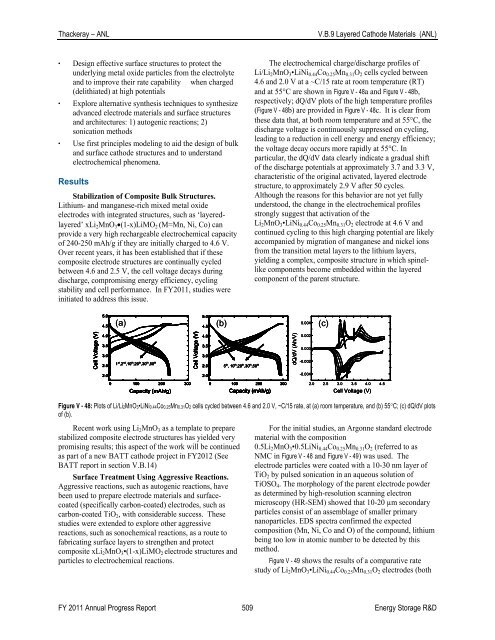V. Focused Fundamental Research - EERE - U.S. Department of ...
V. Focused Fundamental Research - EERE - U.S. Department of ...
V. Focused Fundamental Research - EERE - U.S. Department of ...
Create successful ePaper yourself
Turn your PDF publications into a flip-book with our unique Google optimized e-Paper software.
Thackeray – ANL<br />
V.B.9 Layered Cathode Materials (ANL)<br />
· Design effective surface structures to protect the<br />
underlying metal oxide particles from the electrolyte<br />
and to improve their rate capability when charged<br />
(delithiated) at high potentials<br />
· Explore alternative synthesis techniques to synthesize<br />
advanced electrode materials and surface structures<br />
and architectures: 1) autogenic reactions; 2)<br />
sonication methods<br />
· Use first principles modeling to aid the design <strong>of</strong> bulk<br />
and surface cathode structures and to understand<br />
electrochemical phenomena.<br />
Results<br />
Stabilization <strong>of</strong> Composite Bulk Structures.<br />
Lithium- and manganese-rich mixed metal oxide<br />
electrodes with integrated structures, such as ‘layeredlayered’<br />
xLi 2 MnO 3 (1-x)LiMO 2 (M=Mn, Ni, Co) can<br />
provide a very high rechargeable electrochemical capacity<br />
<strong>of</strong> 240-250 mAh/g if they are initially charged to 4.6 V.<br />
Over recent years, it has been established that if these<br />
composite electrode structures are continually cycled<br />
between 4.6 and 2.5 V, the cell voltage decays during<br />
discharge, compromising energy efficiency, cycling<br />
stability and cell performance. In FY2011, studies were<br />
initiated to address this issue.<br />
The electrochemical charge/discharge pr<strong>of</strong>iles <strong>of</strong><br />
Li/Li 2 MnO 3 •LiNi 0.44 Co 0.25 Mn 0.31 O 2 cells cycled between<br />
4.6 and 2.0 V at a ~C/15 rate at room temperature (RT)<br />
and at 55C are shown in Figure V - 48a and Figure V - 48b,<br />
respectively; dQ/dV plots <strong>of</strong> the high temperature pr<strong>of</strong>iles<br />
(Figure V - 48b) are provided in Figure V - 48c. It is clear from<br />
these data that, at both room temperature and at 55C, the<br />
discharge voltage is continuously suppressed on cycling,<br />
leading to a reduction in cell energy and energy efficiency;<br />
the voltage decay occurs more rapidly at 55C. In<br />
particular, the dQ/dV data clearly indicate a gradual shift<br />
<strong>of</strong> the discharge potentials at approximately 3.7 and 3.3 V,<br />
characteristic <strong>of</strong> the original activated, layered electrode<br />
structure, to approximately 2.9 V after 50 cycles.<br />
Although the reasons for this behavior are not yet fully<br />
understood, the change in the electrochemical pr<strong>of</strong>iles<br />
strongly suggest that activation <strong>of</strong> the<br />
Li 2 MnO 3 •LiNi 0.44 Co 0.25 Mn 0.31 O 2 electrode at 4.6 V and<br />
continued cycling to this high charging potential are likely<br />
accompanied by migration <strong>of</strong> manganese and nickel ions<br />
from the transition metal layers to the lithium layers,<br />
yielding a complex, composite structure in which spinellike<br />
components become embedded within the layered<br />
component <strong>of</strong> the parent structure.<br />
5.0 5.0<br />
(a)<br />
4.5 4.5<br />
(b)<br />
0.004<br />
(c)<br />
ltag<br />
age (V)<br />
Cell Volt<br />
4.0<br />
3.5<br />
3.0<br />
2.5<br />
1 st ,2 nd ,10 th ,20 th ,30 th ,50 th<br />
Cell Voltage (V)<br />
4.0<br />
3.5<br />
3.0<br />
2.5<br />
5 th , 10 th ,20 th ,30 th ,50 th<br />
dQ/dV (Ah/V)<br />
0.002<br />
0.000<br />
-0.002<br />
2.0 2.0<br />
0 100 200 300<br />
Capa<br />
paci<br />
city<br />
(mAh/g)<br />
-0.004<br />
0 100<br />
200 300<br />
2.0 2.5 3.0 3.5 4.0 4.5<br />
Capacity (mAh/g<br />
) Cell Voltag<br />
age (V)<br />
Figure V - 48: Plots <strong>of</strong> Li/Li2MnO3•LiNi0.44Co0.25Mn0.31O2 cells cycled between 4.6 and 2.0 V, ~C/15 rate, at (a) room temperature, and (b) 55C; (c) dQ/dV plots<br />
<strong>of</strong> (b).<br />
Recent work using Li 2 MnO 3 as a template to prepare<br />
stabilized composite electrode structures has yielded very<br />
promising results; this aspect <strong>of</strong> the work will be continued<br />
as part <strong>of</strong> a new BATT cathode project in FY2012 (See<br />
BATT report in section V.B.14)<br />
Surface Treatment Using Aggressive Reactions.<br />
Aggressive reactions, such as autogenic reactions, have<br />
been used to prepare electrode materials and surfacecoated<br />
(specifically carbon-coated) electrodes, such as<br />
carbon-coated TiO 2 , with considerable success. These<br />
studies were extended to explore other aggressive<br />
reactions, such as sonochemical reactions, as a route to<br />
fabricating surface layers to strengthen and protect<br />
composite xLi 2 MnO 3 •(1-x)LiMO 2 electrode structures and<br />
particles to electrochemical reactions.<br />
For the initial studies, an Argonne standard electrode<br />
material with the composition<br />
0.5Li 2 MnO 3 •0.5LiNi 0.44 Co 0.25 Mn 0.31 O 2 (referred to as<br />
NMC in Figure V - 48 and Figure V - 49) was used. The<br />
electrode particles were coated with a 10-30 nm layer <strong>of</strong><br />
TiO 2 by pulsed sonication in an aqueous solution <strong>of</strong><br />
TiOSO 4 . The morphology <strong>of</strong> the parent electrode powder<br />
as determined by high-resolution scanning electron<br />
microscopy (HR-SEM) showed that 10-20 µm secondary<br />
particles consist <strong>of</strong> an assemblage <strong>of</strong> smaller primary<br />
nanoparticles. EDS spectra confirmed the expected<br />
composition (Mn, Ni, Co and O) <strong>of</strong> the compound, lithium<br />
being too low in atomic number to be detected by this<br />
method.<br />
Figure V - 49 shows the results <strong>of</strong> a comparative rate<br />
study <strong>of</strong> Li 2 MnO 3 •LiNi 0.44 Co 0.25 Mn 0.31 O 2 electrodes (both<br />
FY 2011 Annual Progress Report 509 Energy Storage R&D



